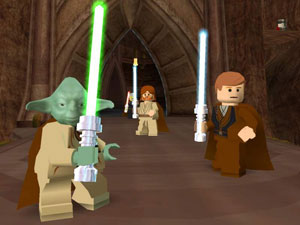I’ve honestly lost count of the number of times that an insipid and distinctly average 3D platformer with a crappy anthropomorphic mascot has tried to excuse itself based on the fact that “it’s a kids’ game”. It’s as if they think kids are too vacuous to play anything that could actually be considered decent and so think it’s better to patronise them with some half-baked tat that only the most moronic would enjoy than to make something that is actually a good game (in that you don’t have to be on Valium enjoy it) but is accessible enough for kids to play.
Arguably Nintendo are the masters of doing that but, once in a while, someone else will manage to press all the right buttons and come out with something fun for all ages. Lego Star Wars is one of those games.

It’s a fairly gimmicky concept and it can spoil much of Revenge of the Sith for you, but the developers haven’t made the mistake of taking themselves too seriously – characters fall into pieces of Lego brick when you kill them and some artistic licence has been taken with certain events to good comic effect, and the simple controls combined with wealth of playable characters with their own attacks and special abilities manage to be simple enough for young children but provide enough variety for the Star Wars buffs who won’t be able to resist it to enjoy. The characters fall into basic categories within which they all control similarly (with the notable exception of Yoda I defy you to spot the differences between the Jedi) but each one has its own animations and idiosyncrasies, and the forced (no pun intended) interaction with different types of character keep things interesting.
The game isn’t long by any means but in an effort to keep players coming back it has the obligatory collectables to encourage replays (unlocking characters and parts of larger Star Wars Lego kits, for example). I can’t really see it bringing most people back far beyond the time it takes to go through the main game but when the game is probably a lot better than the main movie tie-in will be and they’ve infused it with this much charm it’s hard not to like. They’ve put it out for a cheaper price than normal (£29.99) and if you’re looking for some simple fun or something to entertain the kids you can’t go wrong with it.
